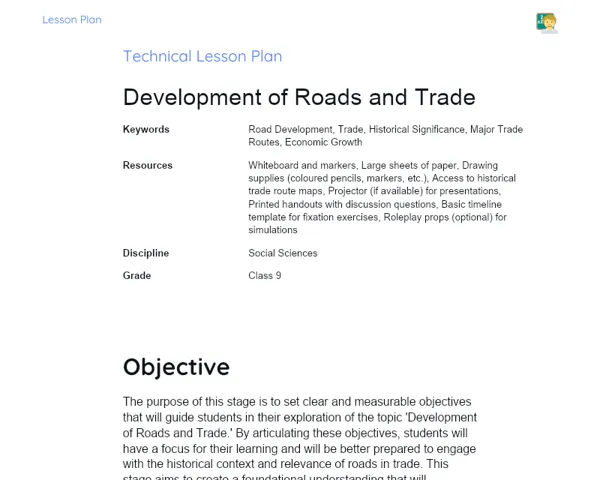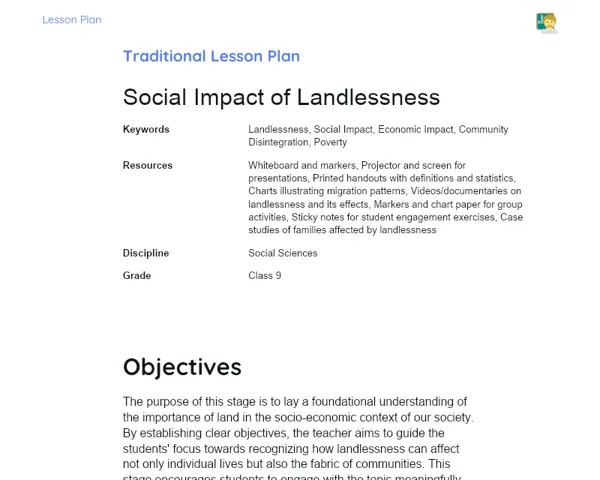Lesson Plan | Socioemotional Learning | Understanding the Importance of Cleanliness
| Keywords | Cleanliness, Personal Hygiene, Environmental Cleanliness, Community Health, Socioemotional Learning, RULER Method, Self-Awareness, Self-Management, Responsible Decision-Making, Social Skills, Social Awareness, Role Play, Mindfulness, Reflection, Goal Setting |
| Resources | Whiteboard and markers, Notebooks and pens for each student, Scenario cards for role play activities, Meditation cushions or mats (if available), Cleanliness checklist templates, Art supplies for creating posters (optional), Posters or images depicting cleanliness and hygiene, Access to a clean space for group activities or role play, Digital devices for researching community cleanliness initiatives (optional) |
| Codes | - |
| Grade | Class 9 |
| Discipline | Social Sciences |
Objectives
Duration: (10 - 15 minutes)
The purpose of this objectives step in the Socioemotional Lesson Plan is to set a clear foundation for students to explore the critical role cleanliness plays in promoting health and well-being. By articulating specific objectives, students are guided to engage with the content both intellectually and emotionally, enabling them to connect personal experiences with the broader societal implications of cleanliness. This step aims to foster self-awareness and encourage thoughtful social interaction among peers, highlighting how individual choices contribute to collective health and social responsibility.
Main Objectives
1. To help students recognize and understand the importance of cleanliness in their personal lives and the community.
2. To encourage students to identify and label their emotions related to cleanliness and personal hygiene practices.
Introduction
Duration: (15 - 20 minutes)
Emotional Warmup Activity
Finding Your Cleanliness Zone
Guided Mindfulness Meditation
1. Begin the session by asking students to find a comfortable seated position, with their feet flat on the floor and hands resting on their laps.
2. Instruct them to close their eyes gently and take a deep breath in through the nose, filling their lungs completely.
3. Encourage students to slowly exhale through their mouths, releasing any tension they might be holding in their bodies.
4. Guide them to focus on their breath for a few moments, noticing the rise and fall of their chest with each inhale and exhale.
5. Introduce a visualization element where they imagine a clean and peaceful space, such as a tidy room or a sparkling garden, and encourage them to reflect on the feelings of calmness and joy it brings.
6. Ask them to think about how cleanliness positively affects their lives and the lives of those around them.
7. After a few minutes, gently guide the students back to the present by asking them to take a few more deep breaths.
8. Finally, encourage them to open their eyes and bring their awareness back to the room, feeling refreshed and focused.
Content Contextualization
Cleanliness is much more than just a personal choice; it resonates deeply within our lives and communities. Consider how a clean environment can uplift the spirits of a community. When one walks into a well-maintained park or sees a tidy classroom, it instills a sense of pride and responsibility. Local festivals, like Ganesh Chaturthi, often emphasize cleanliness, where the community comes together to clean the environment as an expression of love and respect for nature. Such practices not only enhance health but also foster social bonds, reinforcing the idea that our individual actions contribute to collective wellbeing. Understanding the societal implications of cleanliness demonstrates how each person's commitment can lead to a healthier, cleaner community, sparking both interest and motivation among students to engage in this vital topic.
Development
Duration: (60 - 75 minutes)
Theory Guide
Duration: (15 - 20 minutes)
1. Cleanliness is defined as the state of being free from dirt, dust, and impurities. It is crucial for maintaining personal hygiene and overall health.
2. The main components of cleanliness include personal hygiene, environmental cleanliness, and the societal impacts of cleanliness. Personal hygiene refers to practices like bathing, brushing teeth, and wearing clean clothes, which directly affect individual health.
3. Environmental cleanliness refers to the state of public and private spaces, such as homes, schools, and parks. A clean environment contributes to better mental health and community pride.
4. The societal impacts of cleanliness can be seen in festivals and community initiatives that emphasize cleanliness, such as the Swachh Bharat Abhiyan in India, which aims to promote clean and open defecation-free villages.
5. Examples of cleanliness in action include regular handwashing, the practice of throwing garbage in bins, and community clean-up drives. Each of these actions not only contributes to one's health but also fosters a sense of responsibility towards the community.
6. An analogy to help students understand the importance of cleanliness could be likening a clean home or classroom to a well-tended garden; just as a garden flourishes with care, so too do our lives and communities thrive in cleanliness.
Activity with Socioemotional Feedback
Duration: (20 - 25 minutes)
Cleanliness Role Play
In this activity, students will participate in role-play scenarios where they will act out various situations involving cleanliness or lack thereof. This interactive engagement will help them connect emotionally to the topic, understand the consequences of cleanliness, and foster empathy among peers. Students will be divided into small groups, each receiving a scenario related to cleanliness—such as a messy classroom, a dirty public space, or a personal hygiene situation. Students will then demonstrate how characters in their scenarios react, and how cleanliness (or the lack thereof) affects them and the community.
1. Divide the class into small groups of 4-5 students.
2. Distribute different scenarios to each group related to cleanliness challenges.
3. Allow groups 10 minutes to prepare their role plays, encouraging creativity in their presentations.
4. Each group will present their role play to the class (5 minutes per group).
5. After each presentation, facilitate a brief discussion on the emotions involved, the consequences of the actions portrayed, and what could be done differently.
Discussion and Group Feedback
After each presentation, guide a group discussion where students can reflect on what they recognized in the scenarios. Begin with the RULER method by asking students to recognize their emotions during the role plays. What did they feel when they saw a dirty environment or a character ignoring personal hygiene? Next, encourage them to understand the causes and consequences of these feelings, discussing how cleanliness—or the lack thereof—affects individuals and communities. As they label their emotions, guide them to express how they feel about cleanliness in their lives and the importance of making responsible decisions regarding this topic. Finally, help students regulate their emotions by discussing positive actions they can take to promote cleanliness in their own lives and communities, reinforcing constructive behaviors and choices.
Conclusion
Duration: (15 - 20 minutes)
Reflection and Emotional Regulation
To conclude the lesson, the teacher will facilitate a group discussion where students reflect on the challenges they faced during the lesson regarding cleanliness. The teacher will prompt students to share how they managed their emotions when confronted with scenarios of cleanliness or lack thereof. Additionally, students will be encouraged to write a brief paragraph in their notebooks reflecting on one specific moment in the lesson that stood out to them, particularly focusing on how they felt and the strategies they used to handle those emotions. This written reflection will allow students to process their thoughts and feelings more deeply.
Objective: The objective of this reflection and emotional regulation subsection is to encourage students to engage in self-assessment, thereby helping them identify effective emotional management strategies in response to challenging situations related to cleanliness. This step promotes self-awareness and aids in developing their capacity to regulate emotions, ultimately contributing to their personal growth and social responsibility.
Glimpse into the Future
At the end of the lesson, the teacher will guide students in setting personal and academic goals related to cleanliness. Students will be asked to think about one personal goal they can implement in their daily lives to improve hygiene or cleanliness and one academic goal they can pursue, such as researching community cleanliness initiatives. The teacher will encourage students to share these goals with a partner to foster accountability.
Setting Goals:
1. Maintain personal hygiene by bathing regularly and wearing clean clothes.
2. Participate in a community clean-up drive every semester.
3. Research and present on the effects of cleanliness on community health.
4. Create a personal cleanliness checklist and review it weekly.
5. Engage in discussions about cleanliness at home and encourage family members to adopt good hygiene practices. Objective: The objective of the ending activity is to strengthen students' autonomy and promote the practical application of their learning regarding cleanliness and hygiene. By setting personal and academic goals, students can take ownership of their actions and understand how their commitments contribute to their overall well-being and that of their community.



